
2024 has barely begun, and we already have two of the most compelling Android flagships to launch this year: the Samsung Galaxy S24 Ultra and the OnePlus 12. While the OnePlus 12 banks on top-notch hardware, superfast charging, and an unrealistically bright display, the Galaxy S24 Ultra improves upon an already promising set of cameras and promises longevity through seven years of software updates.
- Samsung Galaxy S24 Ultra vs. OnePlus 12: specs
- Samsung Galaxy S24 Ultra vs. OnePlus 12: design
- Samsung Galaxy S24 Ultra vs. OnePlus 12: display
- Samsung Galaxy S24 Ultra vs. OnePlus 12: performance
- Samsung Galaxy S24 Ultra vs. OnePlus 12: battery and charging
- Samsung Galaxy S24 Ultra vs. OnePlus 12: cameras
- Samsung Galaxy S24 Ultra vs. OnePlus 12: software and updates
- Samsung Galaxy S24 Ultra vs. OnePlus 12: price and availability
- Samsung Galaxy S24 Ultra vs. OnePlus 12: verdict
The Galaxy S24 Ultra was released on January 31, and the OnePlus 12 was announced globally for release on February 6. For a starting price of $1,300, the Galaxy S24 Ultra offers a strong backbone of features that rely on Google’s Gemini Nano framework to run myriad AI applications on the device
The OnePlus 12, like recent OnePlus flagships, touts hardcore specs, a new and improved camera setup, and the welcome return of wireless charging. It is also much lucratively priced, at $800, as compared to the Galaxy S24 Ultra.
The OnePlus 12 and Samsung Galaxy S24 Ultra are dominant choices in their respective price segments. While they’ll likely lie far apart on the price scale, similar features make them each others’ worthy competitors. If you look forward to buying one of these phones, here is what you should expect them to offer.
Samsung Galaxy S24 Ultra vs. OnePlus 12: specs
| Samsung Galaxy S24 Ultra | OnePlus 12 | |
|---|---|---|
| Size | 162.5 × 79 × 8.6mm (6.40 x 3.11 x 0.34 inches) | 164.3 x 75.8 x 9.2mm (6.46 x 2.98 x 0.36) |
| Weight | 233 grams (8.22 ounces) | 220 grams (7.76 ounces) |
| Screen |
|
|
| Operating system | One UI 6.1 based on Android 14 | OxygenOS 14 based on Android 14 (expected) |
| RAM & Storage |
|
|
| Processor | Qualcomm Snapdragon 8 Gen 3 “For Galaxy” | Qualcomm Snapdragon 8 Gen 3 |
| Camera |
|
|
| Video |
|
|
| Connectivity |
|
|
| Ports | USB-C | USB-C Gen 3.2 |
| Water resistance | IP68 | IP65 |
| Battery & charging | 5,000mAh with 45W wired fast charging and 15W wireless charging | 5,400mAh with 80W SuperVOOC wired fast charging and 50W AirVOOC wireless charging |
| Colors | Black, Gray, Violet, Yellow | Black, Silver, Green |
| Price | Starting at $1,300 | Starting at $800 |
Samsung Galaxy S24 Ultra vs. OnePlus 12: design
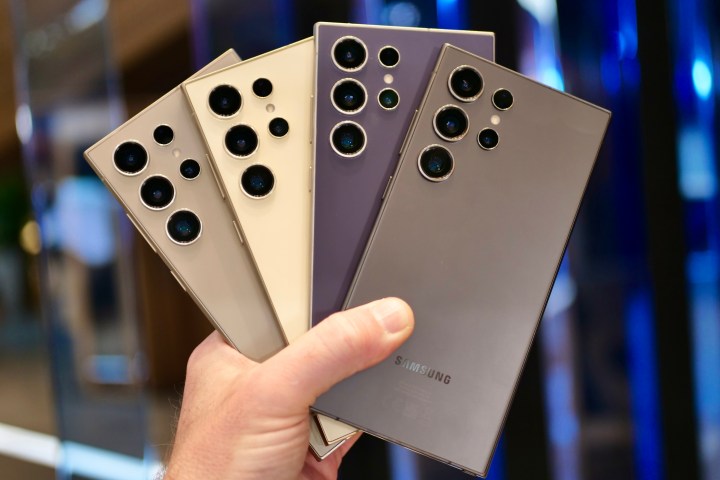
Instead of reinventing the respective designs, both Samsung and OnePlus are sticking with the same designs from last year with minimal changes. The biggest design change on the Galaxy S24 Ultra comes in the form of a titanium frame — unapologetically inspired by the iPhone 15 Pro — surrounding the phone from all four edges. Notably, the titanium frame is exclusive to the Ultra, while the other two Galaxy S24 devices will continue to feature a toughened aluminum alloy frame from the previous generation. This new material does not make the Galaxy S24 Ultra substantially lighter, despite lightweight and durability being key attributes of titanium.
The buttons, ports, and camera module on the Galaxy S24 Ultra stay where they were previously. Despite initial rumors, the Galaxy S24 Ultra has shed a few millimeters and is now thinner than the Galaxy S23 Ultra and OnePlus 12. The S Pen has been carried over for yet another generation and now has a flatter head to match the sharp edges at the top and bottom. Meanwhile, the speaker grille from the Galaxy S23 Ultra has been replaced by a simpler bar-shaped opening at the bottom. The titanium alloy renders a smoother texture than the shiny frame from the previous generation, even though it may appear coarse. There are new yellow and violet colors this time around for the Galaxy S24 Ultra, while Samsung is dropping the green from last year.
In his Galaxy S24 Ultra review, Digital Trends’ Andy Boxall highlights that the titanium frame is visually more appealing, less curvy, more grippy, and appears to be more scratch-resistant than the Galaxy S23 Ultra.
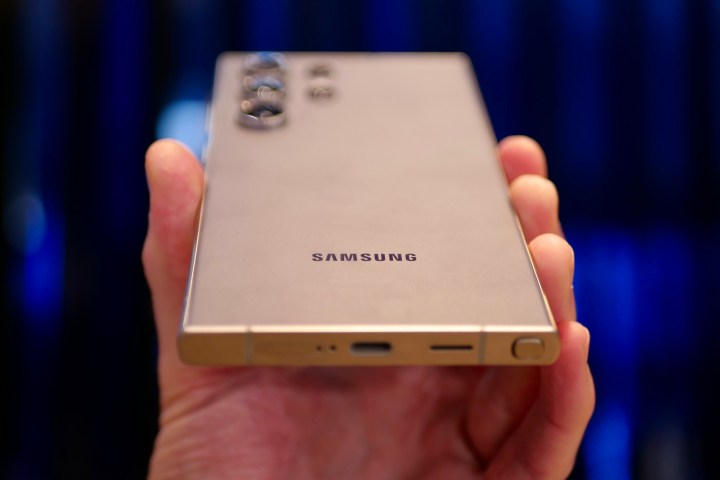
Other changes to the design include a display that is now flatter along the edges to, as Samsung claims, improve visibility and offer better productivity. The Galaxy S24 Ultra will be the first smartphone to feature the new Gorilla Glass Armor, which is significantly tougher than the previous Victus 2 and reduces reflectivity by up to 75% to improve readability on the display. The flat screen further improves writing with the S Pen.
Like Samsung, OnePlus is sticking to the previously tried and tested design seen on the OnePlus 11 and the OnePlus 11R — but the camera bump is noticeably more prominent than the previous year. To mark the differences, the OnePlus 12 gets a textured finish under the back glass, identical to the Marble Odyssey edition of the OnePlus 11. The texture is limited to a new green color variant, while two other colors — white and black with matching chrome-finish frames — come with plain backs.

Despite the same design, the OnePlus 12 weighs 220 grams (7.76 ounces) compared to the OnePlus 11’s 205g (7.23 ounces) and is noticeably thicker. These changes have seemingly been made to make room for a larger battery on the OnePlus 12. As my colleague Christine Romero-Chan points out in her OnePlus 12 review, the thin frame lends to an illusion of the phone being slimmer than it actually is. However, with brands like Samsung withdrawing from the curved-edge club, the OnePlus 12 may not seem as premium or appealing to everyone.
All of the Galaxy S24 phones offer ultimate dust and water resistance with an IP68 rating. This means it can be doused under freshwater for up to 30 minutes at a depth of 1.5 meters (roughly 5 feet). In comparison, the OnePlus 12 only comes with an IP65 rating. While that is technically an upgrade over the OnePlus 11’s IP64 rating, the OnePlus 12 can only withstand light showers and drizzles and is not recommended to be submerged underwater.
Notably, irrespective of their individual resistance against water, neither company claims complete protection and will not cover water-related damages under warranty. You can, however, purchase Samsung Care+ for unlimited coverage in case of accidental damages, while OnePlus offers no such protection plans for now.
Winner: Samsung Galaxy S24 Ultra
Samsung Galaxy S24 Ultra vs. OnePlus 12: display
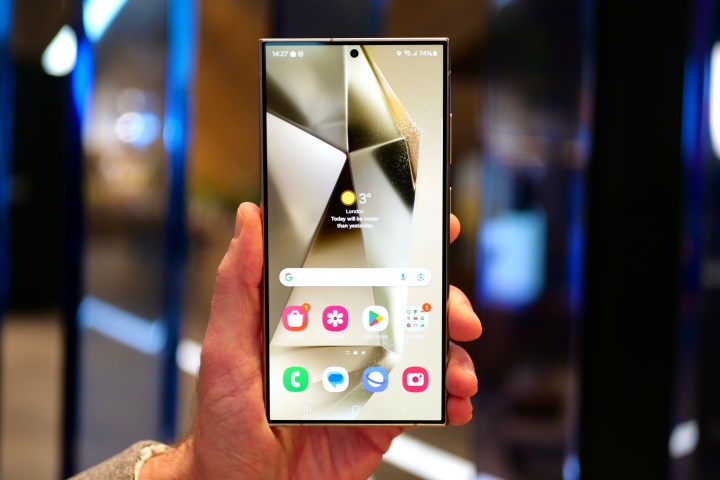
The Galaxy S24 Ultra features a 6.8-inch display — the same size as the S23 Ultra. But to accommodate changes to its design (i.e., the flatter bezels), the display’s resolution has been tweaked to 1,440 x 3,120 pixels, making it marginally taller than the Galaxy S23 Ultra. Notably, the curved part is now limited to the bezels surrounding the display and does not extend to the lit areas.
Besides flatter bezels, the Galaxy S24 Ultra’s display is significantly brighter than the S23 Ultra. The peak brightness is pushed to 2,600 nits compared to the Galaxy S23 Ultra’s 1,750 nits. Notably, peak brightness only signifies the highest level of illumination per pixel (instead of the screen as a whole) and is usually measured when viewing HDR content. The actual brightness of the screen may be lower than the mentioned value. Samsung does not reveal those figures for the overall screen’s brightness.
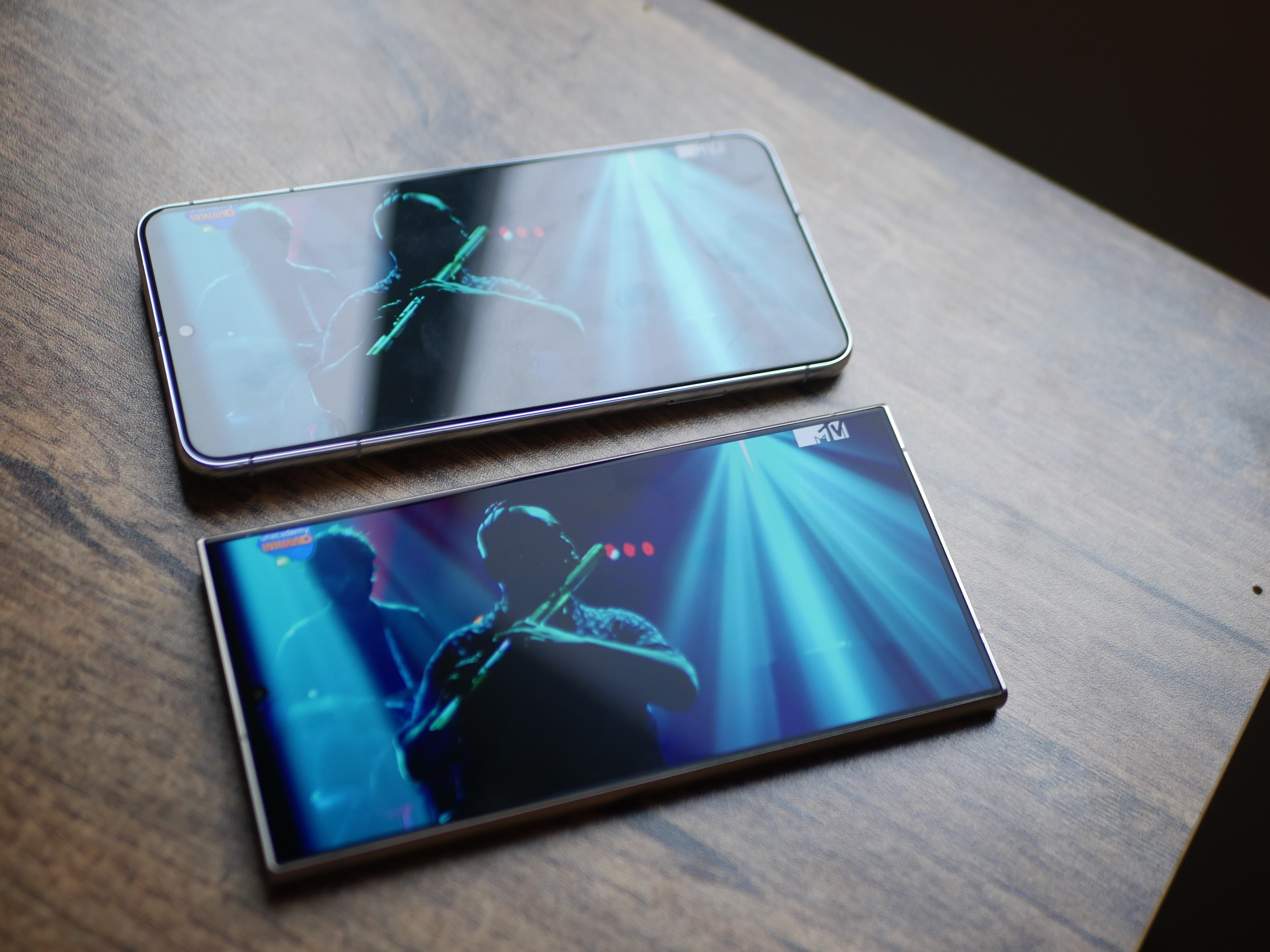
The upgraded display also supports refresh rates ranging from 1Hz to 120Hz, powered by LTPO technology that allows it to automatically switch to a lower refresh rate based on the frame rate of the screen’s content.
With the Galaxy S24 Ultra’s display set for a significant upgrade, the OnePlus 12 isn’t lagging. It gets a tad bigger 6.82-inch AMOLED panel with 1440 x 3168 pixel resolution. The OnePlus 12’s display also supports refresh rate intervals ranging between 1 and 120Hz, using LTPO technology.
Both phones also allow you to reduce the screen resolution to Full HD+ in order to help conserve battery. On top of that, the OnePlus 12 offers software enhancements to upscale low-resolution videos or automatically convert standard dynamic range to high dynamic range (SDR to HDR) content.
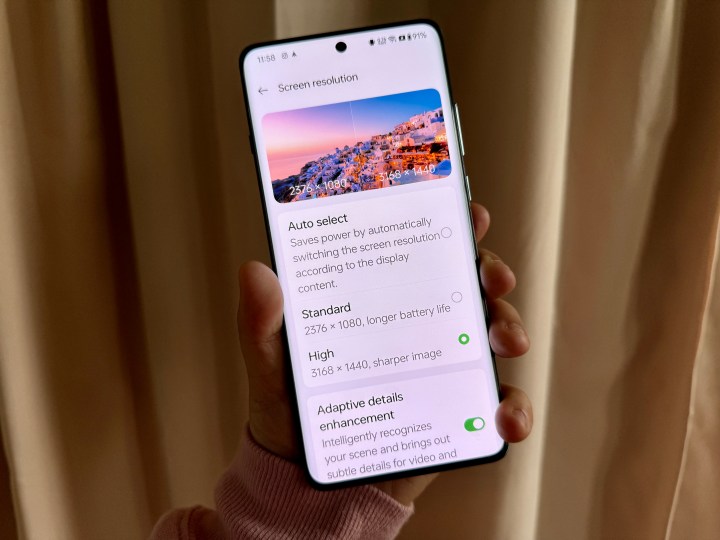
OnePlus’ claims about the display’s brightness surpass Samsung’s by a large margin. The new display gets a massive bump in brightness, now supporting up to 4,500 nits peak brightness with 1,600 nits using the High Brightness Mode. As with the Galaxy S24 Ultra, it’s essential to emphasize the role of HDR content in measuring the peak brightness.
The OnePlus 12 also incorporates features such as a high pulse-width modulation (PWM) frequency of 2,160Hz to reduce eye strain that may be otherwise caused by using the phone under dim light. Meanwhile, the company’s new “Rain Water Touch” tech is designed to let you use the phone even when you have wet hands.
Unlike the flat panel on the Galaxy S24 Ultra, OnePlus sticks to a curved panel as on the previous flagship, which makes the phone appear thinner but can lead to accidental touches. On the durability front, it still uses the Gorilla Glass Victus 2 from last year — which may not be ineffective, just not as durable as the new Gorilla Glass Armor that Samsung is using.
While the OnePlus 12 feels noticeably brighter than the Galaxy S24 Ultra, this isn’t necessarily a loss for Samsung. Both phones feel amply bright, even under bright light. The Galaxy S24 Ultra blocks out harsh light better, thanks to the less reflective Gorilla Glass Armor protection.
Winner: Samsung Galaxy S24 Ultra
Samsung Galaxy S24 Ultra vs. OnePlus 12: performance
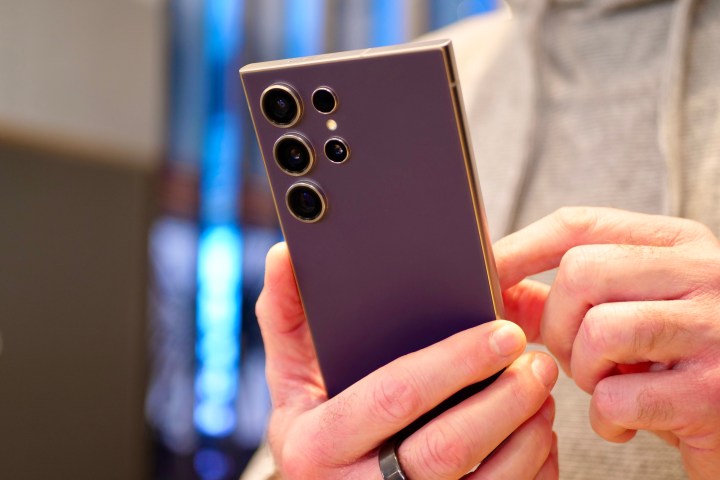
For several past generations of flagships, Samsung has had a dual-chip strategy, where the models in the majority of the markets, including the U.S., receive the latest and most powerful chipset in the Qualcomm Snapdragon range, while some markets get Samsung’s own Exynos-branded silicon. Samsung discontinued the policy in 2023, releasing all models with a supercharged Snapdragon 8 Gen 2 “For Galaxy” variant due to the late-stage cancellation of the Exynos 2300.
In 2024, however, the brand is reverting to using different chips based on the region, arming all Galaxy S24 series phones with the latest Snapdragon 8 Gen 3 in the U.S. In other markets, the Galaxy S24 and the S24 Plus models run on Samsung’s custom Exynos 2400 platform, while the Galaxy S24 Ultra runs the Qualcomm chip worldwide.
Per official specs, Samsung uses a Snapdragon 8 Gen 3 “For Galaxy” for the Galaxy S24 Ultra. However, it does not mention the exact improvements over the standard design of the chipset, so it’s unclear if the chip receives any special treatment for another year or if the suffix is simply for optics.
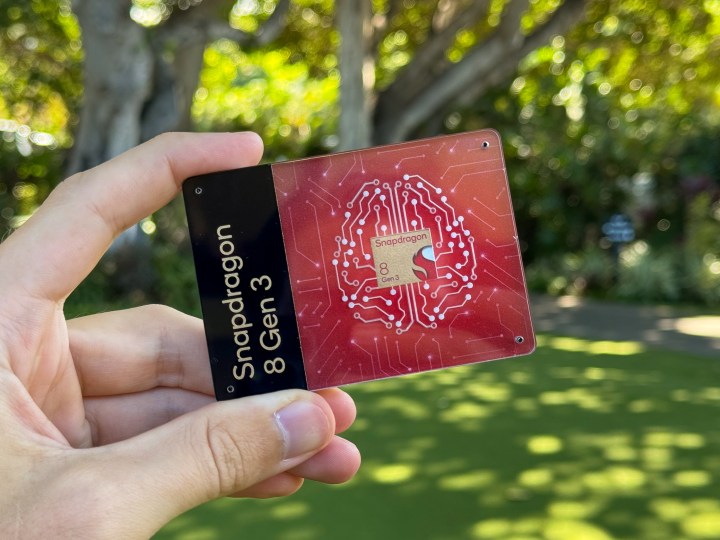
As per Qualcomm, the Snapdragon 8 Gen 3 brings a 30% more powerful CPU, thanks to a new performance-oriented configuration, and 25% better GPU performance than the 8 Gen 2. Qualcomm is also raising the bar with AI-related capabilities, claiming a 98% hike in neural processing tasks and support for on-device AI models.
Meanwhile, Samsung claimed the chipset on the Galaxy S24 Ultra runs a 20% faster CPU, a 30% better GPU, and a 40% better neural processor than the custom “For Galaxy” APU from the previous year. It added that the vapor cooling chamber inside the Galaxy S24 Ultra is now 90% larger than the S23 Ultra, which is expected to allow for smoother performance and less heating during intensive tasks such as gaming or recording 4K or 8K videos. Furthermore, the Galaxy S24 Ultra offers storage capacities ranging from 256GB to 1TB with 12GB of RAM as standard across all storage sizes.
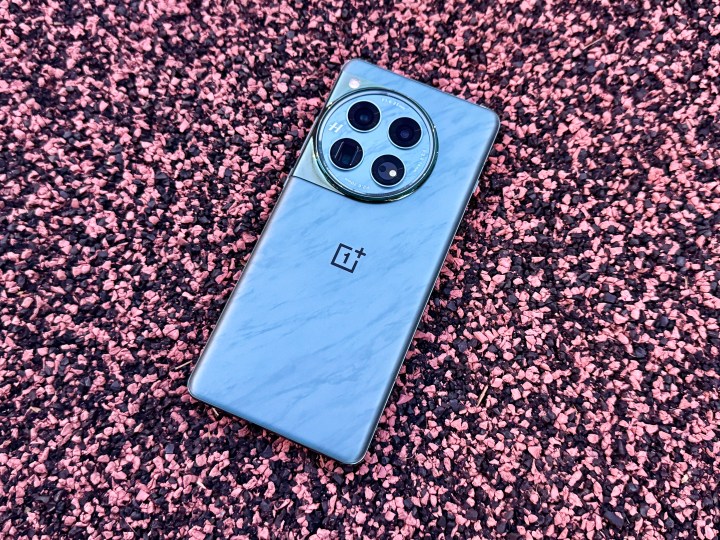
The OnePlus 12 is similarly powered, being one of the earliest devices equipped with the Snapdragon 8 Gen 3 without any unique enhancements. OnePlus also offers up to 24GB of RAM and 1TB of storage in China, but the global models only get 16GB of RAM and up to 512GB of storage. With the hardware stacked inside them, both phones are incredibly powerful and will work relentlessly through every task you assign them.
Samsung has some advantage here, thanks to its partnerships with Google for better AI performance than the OnePlus 12, even though the Snapdragon 8 Gen 3 is optimized for on-device AI processing. These experiences are built into the core of Samsung’s One UI, aiding you in plenty of ways discussed below.
Samsung’s AI frenzy
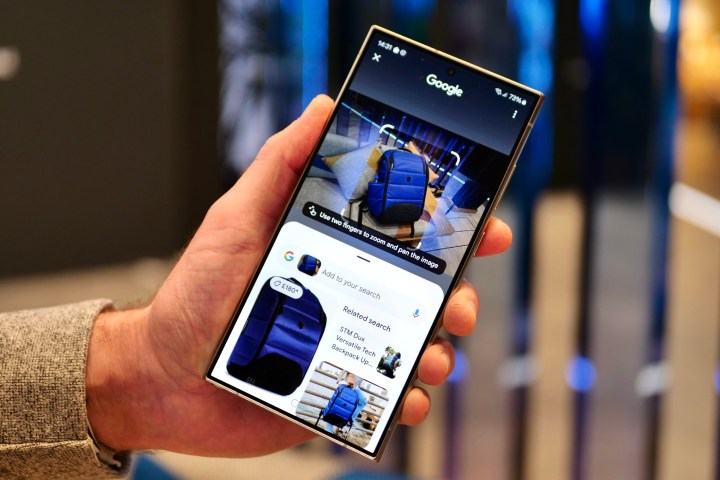
At the launch, Samsung announced a suite of AI features that span beyond the usual improvements to image processing. Instead of developing its own AI, Samsung uses Qualcomm’s hardware prowess and Google’s software chops to run AI applications on the Galaxy S24 series. These rely on Google’s Gemini Nano machine learning algorithm that also powers AI applications on the Pixel 8 series.
Samsung’s suite of AI applications includes the following:
- Live Translate to translate calls or in-person conversations in real time.
- Chat Assist to change the tone of the text in chat applications such as Google Messages and to translate text as you type.
- Note Assist automatically organizes and summarizes haphazardly taken notes.
- Transcript Assist automatically transcribes voice notes.
- Circle to Search is an extension of Google Lens and lets you select a portion of the screen’s contents for a more refined search experience. This comes first to the Galaxy S24 series but is not exclusive to Samsung devices.
- Android Auto will now summarize conversation threads and give you the gist of incoming notifications and messages so you can stay focused on the road.
- Lastly, several new AI features are coming to the Galaxy S24 Ultra cameras, which we discuss below.
These features work as advertised, but you may not always find reasons to use all of them. Circle to Search is definitely one of the features you are likely to use more once you get accustomed to the gestures. Meanwhile, features Chat Assist appear incomplete and require more refinement.
In contrast, OnePlus does not seem to be working on any such AI features that will be integrated into OxygenOS with the OnePlus 12. At a later stage, Google may make these features mainstream in Android. But until then, the Pixel 8 and the Galaxy S24 are superior in terms of AI applications.
Samsung’s AI features can be great, but if you don’t need them, both the S24 Ultra and the OnePlus 12 are performance beasts. As such, we’re calling this one a tie.
Winner: Tie
Samsung Galaxy S24 Ultra vs. OnePlus 12: battery and charging
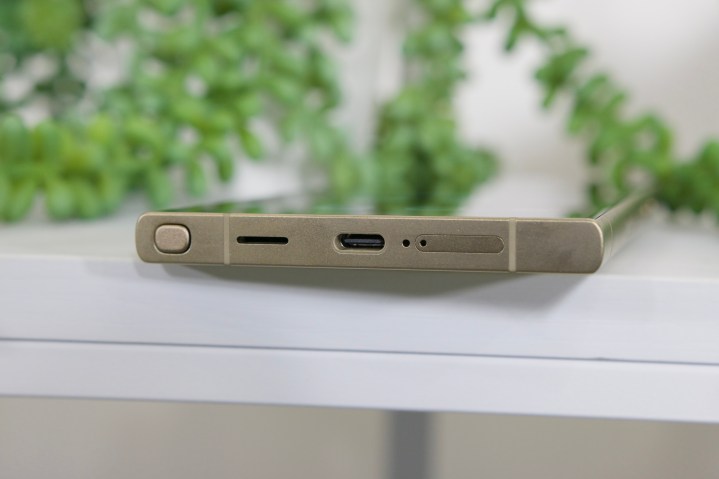
The Galaxy S24 Ultra retains the same 5,000mAh battery as the last two generations with 45-watt wired charging. Instead of using a proprietary standard, the 45W charging is powered by the Programmable Power Supply (or PPS) feature under USB Power Delivery (USB-PD) specifications. If you plan to get the Galaxy S24 Ultra, be prepared to buy a Samsung-branded charging brick separately — although we recommend using one of our recommended multi-port GaN chargers instead. It gets a day-long battery backup, which is impressive for a phone of its size and caliber, but charging speeds can be concerning. Even with a fast GaN charger, the S24 Ultra takes about 70 minutes to charge fully.
Samsung also offers wireless charging on the Galaxy S24 Ultra but appears to skimp on support for the new Qi2 wireless charging standards as on the iPhone 15. You can, however, use a Samsung wireless charger to attain wireless charging speeds up to 15W.
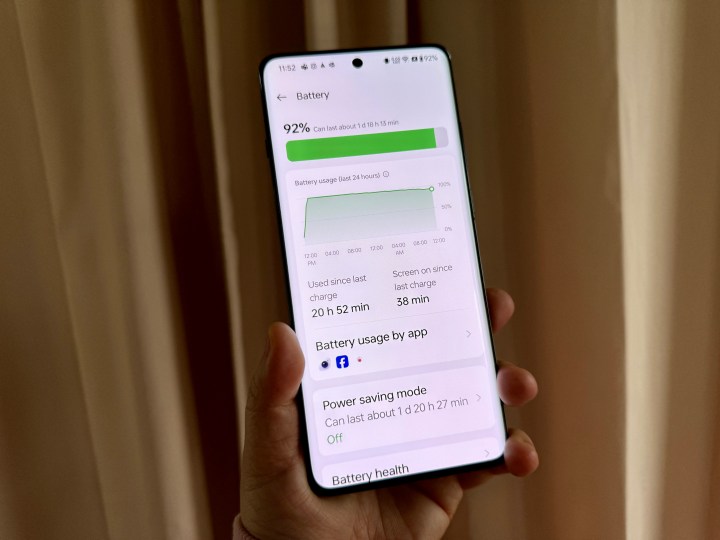
Meanwhile, the OnePlus 12 is furnished with a larger 5,400mAh battery. The international model supports faster charging at up to 100 watts through its proprietary SuperVOOC technology for wired charging, which can charge the phone entirely in under half an hour. However, as with the OnePlus 11, we see the charging speeds limited to 80W in the U.S. Despite this shortcoming, the OnePlus 12 charges much faster than the Galaxy S24 Ultra — or any other phone available in the U.S. It charges to 50% in less than 15 minutes while a full charge only takes 30 minutes. That’s brilliant and unparalleled!
Besides fast wired charging, 50W superfast wireless charging returns to the OnePlus 12 after being dropped from the OnePlus 11. This faster wireless charging runs on OnePlus’ proprietary AirVOOC technology but should also support slower wireless charging through the more common Qi protocol. Using a proprietary wireless charger, you can charge the OnePlus 12 fully in less than an hour — although you will need to buy one separately.
For its faster wired and wireless charging and the inclusion of a power brick within the box, the OnePlus 12 takes a win here by a long margin.
Winner: OnePlus 12
Samsung Galaxy S24 Ultra vs. OnePlus 12: cameras
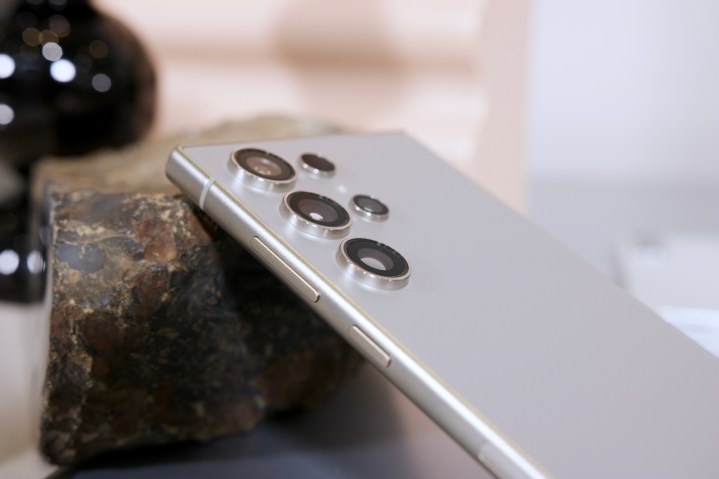
The Samsung Galaxy S23 Ultra led the race with other top-notch mobile cameras last year, and it is natural to expect the same once again. The Galaxy S24 Ultra uses an improved 200MP sensor for the primary camera, which is claimed to be 60% larger than the S23 Ultra. This ensures better retention of light and, therefore, better photography in low light.
While improved hardware is probable, Samsung has already teased improvements to the camera processing, thanks to the onboard AI application.
Besides the improved 200MP primary camera, the Galaxy S24 Ultra receives the same 12MP ultrawide-angle camera and a 10MP portrait telephoto camera with 3x optical zoom as the S23 Ultra. The fourth camera — the periscope — has been upgraded to 50MP but with a reduction in optical zoom from 10x to 5x. Despite regressing in hardware, Samsung claims the new periscope can take better shots than the previous generation. For 10x shots, the camera crops out a section of the 5x image instead of digitally zooming into it, resulting in quality comparable to optical zoom.
Comparing the Galaxy S24 Ultra’s 5x periscope with the S23 Ultra’s 10x astounded us. Instead of being outclassed by the 10x telephoto, Galaxy S24 Ultra’s 5x camera actually performs comparably better in most of our testing scenarios.
Irrespective of the sensor, the Galaxy S24 Ultra heavily relies on AI applications to retouch images. Super HDR allows you to preview photos and videos with HDR even before they have been processed.
The Galaxy S24 Ultra also supports Ultra HDR, an extension of the legacy JPEG image format. In this new format, the HDR metadata is stored alongside the image and only applies if the display is certified for HDR. This essentially allows more optimized image visibility on both HDR and non-HDR displays. This metadata is also transferred to third-party apps such as Instagram or Snapchat (and also captured when images are taken directly in these apps), allowing them to use richer contrast.
The Galaxy S24 Ultra feels a bit stifled in our initial low-light tests. Samsung has traditionally been aggressive with HDR in low-light shots, often making them undesirable. Although minimized over the S23 Ultra, the same appears to be the case with the Galaxy S24 Ultra — at least initially.
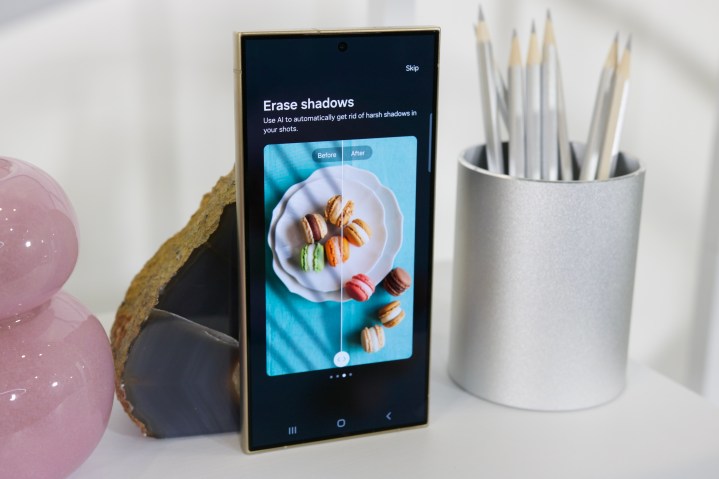
In addition, the Samsung Gallery app now gets new image editing tools, such as Generative Edit, which helps replace or generate new sections in any image using Photoshop-like generative fill.
In comparison, the OnePlus 12 has only three rear cameras. There is a considerable upgrade under the hood, with a new 50MP primary camera featuring Sony’s latest LYT-808 replacing the previous IMX890 on the OnePlus 11. The same sensor is also seen on the OnePlus Open and supports better light absorption despite being much smaller due to advanced stacking techniques. Samsung’s flagship 200MP sensor uses the same technology under the name “D-TVG.” Alongside the new sensor, the OnePlus 12 also gets Hasselblad’s color tuning for a distinctive look.

Besides the primary camera, the OnePlus 12 has a 48MP ultrawide camera and a 64MP periscopic telephoto camera with 3x optical and up to 120x digital zoom. Like Samsung, OnePlus also claims to use AI to enhance long-range shots.
With Haselbald’s backing, the OnePlus 12 takes extremely vibrant images, which look great on the phone’s screen but might appear oversaturated if you plan to print them out. Since that is a rarity, we don’t exactly have complaints about the colors. In low light, the OnePlus 12 appears improved over the OnePlus 11, although there might be some struggle to get the cameras to focus, especially in portrait mode.
Like the Galaxy S24 Ultra, the OnePlus 12 also supports a special format to retain the HDR data and is called “ProXDR.” Unlike the standard Ultra HDR format, OnePlus’ format appears limited to specific OnePlus phones such as the 12 and the Open. However, with Google striving to make this feature a standard part of Android, we can expect the situation to change with future updates.
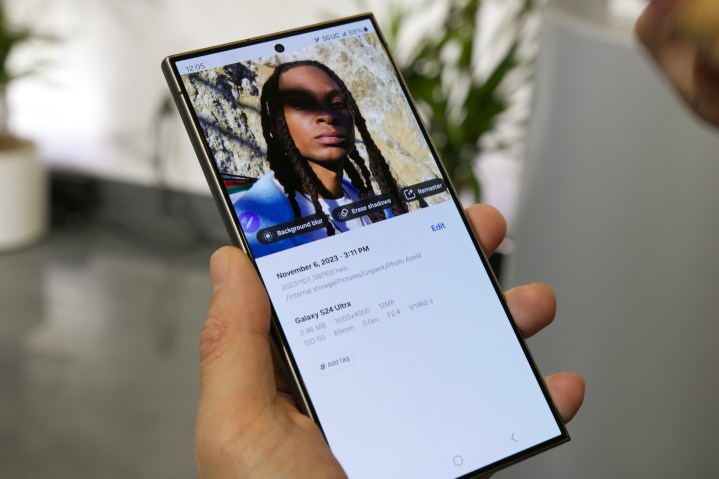
On the front, the Galaxy S24 Ultra gets a 12MP selfie camera with autofocus, while the OnePlus 12 features a 32MP camera with fixed focus.
In terms of videos, both phones can record up to 8K using the rear camera. Both phones also support HDR video recording, but the OnePlus 12 can record with Dolby Vision and RAW footage with LOG. Meanwhile, Samsung can shoot with HDR10+ encoding and allow third-party apps, such as Instagram and Snapchat, to use HDR for video recording.
Based on previous trends, the Galaxy S24 Ultra has the upper hand in photography, although both phones have comparable videography skills. In the coming weeks, we will conduct a direct comparison between the cameras of the two phones.
Winner: Samsung Galaxy S24 Ultra
Samsung Galaxy S24 Ultra vs. OnePlus 12: software and updates

Samsung already offers one of the longest software support to its devices and is taking it to the next level by promising seven years of Android version and security updates. This brings the Galaxy S24 series on par with the Pixel 8, which promises similarly-extended software support. The Galaxy S24 Ultra comes with One UI 6.1 based on Android 14 out of the box.
Meanwhile, the OnePlus 12 can be comes preloaded with OxygenOS 14. Compared to Samsung, OnePlus promises four years of Android updates and five years of security updates.
Despite a different name, OnePlus shares its interface with Oppo’s ColorOS, and the UI lacks any distinctive features and can be more confusing (or overwhelming) than Samsung’s One UI.
Winner: Samsung Galaxy S24 Ultra
Samsung Galaxy S24 Ultra vs. OnePlus 12: price and availability

The base variant of the Galaxy S24 Ultra with 256GB storage costs $1,300, marking a $100 increase over the S23 Ultra. You can buy it on or through the . If you go the latter way, you will also have access to some exclusive dark pastel color options that are not available elsewhere.
Meanwhile, the OnePlus 12 starts at $800 for the 12/256GB model, while the higher 16GB RAM/512GB storage variant is available for $900. The OnePlus 12 can currently be preordered via OnePus’ official store and , and will be available starting February 6.
Samsung Galaxy S24 Ultra vs. OnePlus 12: verdict
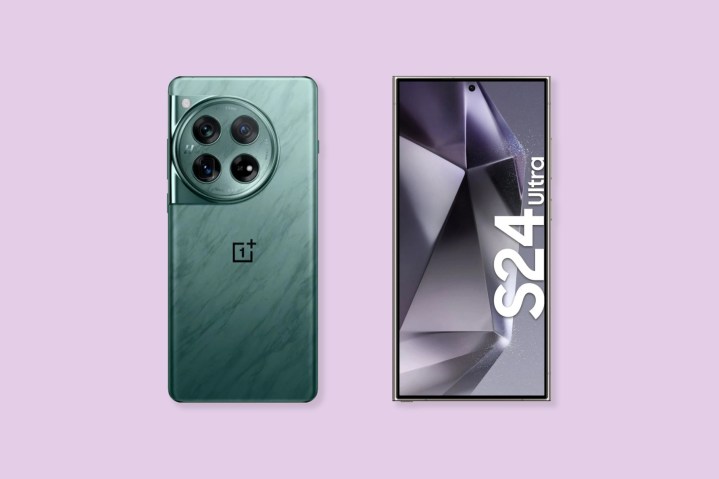
As we mentioned previously, the OnePlus 12 and the Samsung Galaxy S24 Ultra are phones that belong to different segments, especially with the former being much more affordable. To compete with Samsung’s pedigree with superior cameras and a credible history of extended software support, OnePlus offers fierce competition with the same (or even more) vigor and unbeatable charging.
Besides the hardware, Samsung’s venture into AI application makes it a more desirable phone, but only if you can willingly shell out a significantly higher price. You also get an overall better construction, but the OnePlus 12 fights back with a stunningly bright display.
So, despite our reservations about the Galaxy S24 Ultra being a more expensive phone, we cannot instantly dismiss the OnePlus 12 for being less impressive. Both phones appeal to seemingly different audiences but with a noticeable intersection.
If you can compromise on some of the features of the S24 Ultra, the OnePlus 12 is an excellent Android phone to have on your shopping list — and one of the best smartphone values available in 2024. The S24 Ultra technically has the lead with its cameras and AI features, but is that worth an extra $500? If it isn’t for you, you’ve just made your decision.



